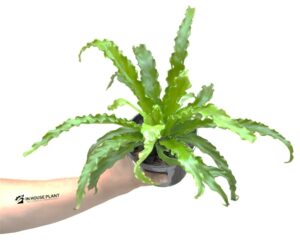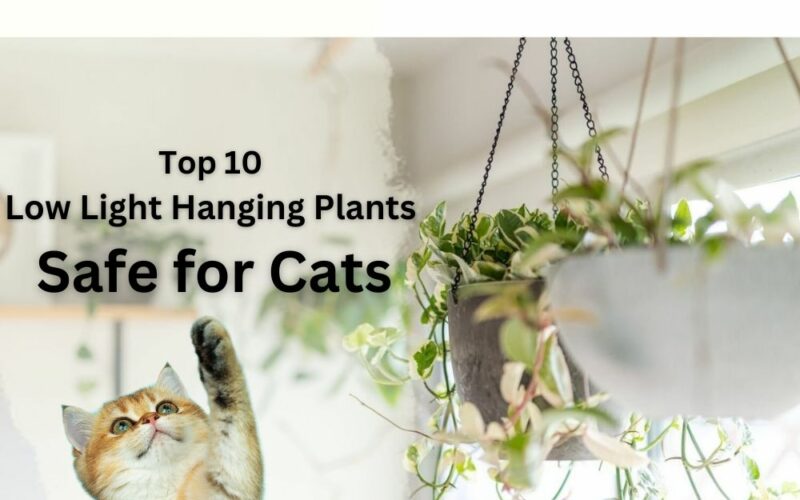If you have a dim corner in your house that wants to give appeal to it by hanging plants but are concerned about your playful kitty, I recommend Ferns such as “Boston Ferns” or “Kimberly Queen Ferns” which can thrive in low-light places and are not toxic for cats too. For more, I’m here with this post to help you with 10 of the best “low light hanging plants safe for cats”.
Here, you will find them with their images, names (common and scientific names), and their caring points. Some of them not only add to your house’s appeal but also can clean indoor air. Keep reading to find them.
➡ ➡ Tips for Beginners about Low-Light Plants:

- A light place is not a dark place, in horticultural science a location far from a light source without any direct light is called low light.
- In low-light conditions, the soil stays wet for a long period, so, avoiding over-watering to prevent root rot.
- Most low-light plants prefer a place with bright indirect sunlight and survive in low-light places without new growth.
- Colourful plants with red, purple, etc colours often return to a green hue in low-light conditions.
What Are “Low Light Hanging Plants Safe for Cats”?
1- Boston Fern:

Scientific name: Nephrolepis exaltata
Other common names: Sword Fern, Wild Boston Fern
Boston Ferns is my favorite hanging houseplant, hence I decided to put them on top of my list. I love them due to they are “low light hanging plants safe for cats” that are excellent air purifiers too. Boston Ferns can remove pollutants like formaldehyde and xylene from the air. Thanks to them.
Everyone loves their lacy and delicate appearance. It’s due to their bright green feathery, arching fronds with tiny leaflets. if you care for them best, they will grow well and will turn into large low-light houseplants that are safe for cats.
Caring points for Boston Ferns:
Watering: Keep the soil consistently moist but not soggy. You can provide it by watering every time you feel the top soil dries out.
Light: Indirect, bright light is ideal although they can tolerate part of shade too. you must avoid direct sunlight; it will cause scorching of the leaves.
Soil: This plant thrives well in a well-draining, rich potting mix.
Fertilization: Feed with a balanced liquid fertilizer every 2-4 weeks during the growing season.
Propagation: you can have new Boston Ferns by division of mature plants.
Temperature: Boston Ferns prefer temperatures between 60-75°F (15-24°C).
Humidity: High humidity is beneficial. So, you can provide high humidity by misting the fronds regularly.
Pests/Diseases: Watch for spider mites and scale. Keep an eye out for fungal diseases if the environment is too damp.
2- Kimberly Queen Fern:

Scientific name: Nephrolepis obliterate
Other common names: Sword Fern, Australian Sword Fern
As you can see in the above picture, Kimberly Queen Ferns have upright, sword-shaped fronds. They are more compact and if you are looking for a fern with a fuller, bushier appearance, Kimberly Queen Ferns can be ideal.
Kimberly Queen Ferns not only are low light hanging plants safe for cats but also are effective air purifiers that can improve indoor air quality. So, they can be the best low-light houseplants for bedrooms too.
Caring points for Kimberly Queen Ferns:
Watering: similar to other ferns, Kimberly Queen Ferns needs to Keep the soil consistently moist.
Light: Indirect, bright light is ideal however you can put it in partial shade corners of your house too. This plant can tolerate some direct sunlight. I discussed the various types of light in different places of your house (depending on the type of windows) in my previous article, although it’s about “bamboo light requirements“, it can be helpful to find the best place for your houseplants too.
Soil: You must provide a soil mix with well-draining, nutrient-rich properties.
Fertilization: Feed with a balanced liquid fertilizer every 2-4 weeks during the growing season.
Propagation: The division of mature plants is the best way to produce new Ferns.
Temperature: It will thrive well in temperatures between 60-75°F (15-24°C).
Humidity: High humidity is beneficial.
Pests/Diseases: Similar to Boston Ferns, it is also sensitive to spider mites and scale. You must also keep an eye out for fungal diseases if the environment is too damp.
3-Bird’s Nest Fern:

Scientific name: Asplenium nidus
Other common names: Nest Fern, Crow’s Nest Fern
Do you know why it’s called Bird’s Nest Ferns? These lovely houseplants have large, wavy fronds that form a rosette appearance. It resembles a bird’s nest. I also love their glossy and vibrant green appearance.
I think these ferns are excellent for adding to your indoor plant collection due to:
- They are low light hanging plants safe for cats
- They add humidity to indoor spaces
- They are also known for their air-purifying qualities.
Caring points for Bird’s Nest Ferns:
Watering: Keep the soil consistently moist.
Light: Indirect, bright light is ideal however can thrive in low light places too. you must avoid direct sunlight.
Soil: Well-draining, rich potting mix is ideal for Bird’s Nest Ferns.
Fertilization: I recommend feeding it with a diluted balanced liquid fertilizer every 4-6 weeks during the growing season.
Propagation: there are two ways for propagating Bird’s Nest Ferns: Spores and division of mature plants.
Temperature: Bird’s Nest Ferns prefers temperatures between 65-75°F (18-24°C).
Humidity: Requires high humidity, so you must mist its foliage.
Pests/Diseases: Watch for mealybugs and scale. Keep an eye out for fungal diseases if the environment is too damp.
4- Nerve Plant:

Scientific name: Fittonia spp.
Other common names: Mosaic Plant, Painted Net Leaf
If you are looking for distinctive, veined leaves hanging plants in various shades of green, white, pink, or red, Nerve Plants can be ideal for you. They are low-growing houseplants that can make attractive ground cover.
Nerve Plants not only are “low light hanging plants safe for cats” with visually appealing but also can help improve indoor air quality by filtering out pollutants.
Caring points for Nerve Plants:
Watering: Keep the soil consistently moist. High humidity is essential.
Light: Bright, indirect light is ideal although can thrive in dim rooms too. Avoid direct sunlight.
Soil: Well-draining, peat-based mix.
Fertilization: Feed with a balanced liquid fertilizer every 2-4 weeks during the growing season.
Propagation: Stem cuttings in water or soil.
Temperature: Prefers temperatures between 70-75°F (21-24°C).
Humidity: Requires high humidity.
Pests/Diseases: Watch for aphids and mites. Prone to root rot if overwatered.
5- Calathea Freddie:

Scientific name: Calathea orbifolia
Other common names: Goeppertia orbifolia, Peacock plant, Zebra plant, Prayer Plant, Pinstripe Plant
I appreciate this hanging plant due to its large, round leaves with silver-green stripes. As you can see in the above picture, the underside of the leaves is often a striking burgundy color.
Calathea plants are known for their unique leaf patterns making them popular as decorative houseplants. I recommend them not only because they are “low light hanging plants safe for cats” but also because of their air-purifying properties.
Caring Points for Calathea plants:
Watering: Keep the soil consistently moist. Provide high humidity.
Light: Indirect, medium to low light is ideal for them however you must avoid direct sunlight.
Soil: Well-draining, peat-based mix.
Fertilization: Feed with a diluted balanced liquid fertilizer every 4-6 weeks during the growing season.
Propagation: Division of mature plants.
Temperature: Prefers temperatures between 65-75°F (18-24°C).
Humidity: Requires high humidity.
Pests/Diseases: Watch for spider mites and aphids. Susceptible to root rot if overwatered.
6- Calathea Rattlesnake:

Scientific name: Calathea lancifolia
Other common names: Rattlesnake Plant, Prayer Plant
A wonderful thing about Calathea Rattlesnake is its long, lance-shaped leaves with a distinctive pattern resembling a rattlesnake’s skin.
Like other Calathea varieties, it is valued for its air-purifying qualities and contributes to a healthier indoor environment. So, these plants are ideal “low light hanging plants safe for cats”.
Caring Points for Calathea Varieties:
Watering: Keep the soil consistently moist. Provide high humidity.
Light: Similar to other Calatheas, they love to thrive in indirect, medium to low light places. Avoid direct sunlight.
Soil: Well-draining, peat-based mix.
Fertilization: Feed with a diluted balanced liquid fertilizer every 4-6 weeks during the growing season.
Propagation: Division of mature plants.
Temperature: Prefers temperatures between 65-75°F (18-24°C).
Humidity: Requires high humidity.
Pests/Diseases: Watch for spider mites and aphids. Susceptible to root rot if overwatered.
7- Baby Rubber Plant:

Scientific name: Peperomia obtusifolia
Other common names: Pepper Face, American Rubber Plant
If you are looking for a compact hanging succulent that is also easy to care for, Baby Rubber Plants are ideal. As you can see in the above picture, they have thick, succulent-like leaves that are glossy and dark green.
I appreciate them for:
- Their aesthetic qualities
- Low maintenance houseplants
- Low light hanging plants safe for cats
Caring points for Baby Rubber Plants:
Watering: Allow the top inch of soil to dry before watering. Do not overwater.
Light: Medium to bright, indirect light. Can tolerate some direct sunlight.
Soil: Well-draining, peat-based mix.
Fertilization: Feed with a balanced liquid fertilizer every 4-6 weeks during the growing season.
Propagation: Leaf or stem cuttings.
Temperature: Prefers temperatures between 65-75°F (18-24°C).
Humidity: Average to high humidity.
Pests/Diseases: Watch for spider mites and mealybugs.
8- String of Hearts:

Scientific name: Ceropegia woodii
Other common names: Chain of Hearts, Rosary Vine
Very gorgeous hanging houseplants. The String of Hearts is one of my favorite indoor plants. It is a trailing succulent with cascading vines of heart-shaped leaves. I love their delicate and charming appearance.
The good news is that this plant is easy to care for and if you want to add a decorative touch to your hanging baskets, they are ideal. They are “low light hanging plants safe for cats” that are valued for their ornamental qualities.
Caring Points for the String of Hearts:
Watering: Allow the soil to dry between waterings. Water sparingly in winter.
Light: Bright, indirect light. Can tolerate some direct sunlight.
Soil: Well-draining succulent mix.
Fertilization: Feed with a diluted balanced liquid fertilizer every 4-6 weeks during the growing season.
Propagation: Stem cuttings.
Temperature: Prefers temperatures between 60-75°F (15-24°C).
Humidity: Average humidity.
Pests/Diseases: Watch for aphids and spider mites.
9- Lipstick Plant:

Scientific name: Aeschynanthus japhrolepis
Other common names: Lipstick Vine, Basket Plant
If you are looking for a flowering houseplant to add colors to your small dim room, Lipstick Plants are ideal. They have dark green leaves and tubular, red, or pink flowers that resemble tubes of lipstick. They are colorful low light indoor plants.
I appreciate them not only for their attractive appearance but also for their ability to filter indoor air pollutants. Besides, Lipstick Plants are also “low light hanging plants safe for cats”.
Caring Points for Lipstick Plants:
Watering: Keep the soil consistently moist during the growing season. Allow slight drying in winter.
Light: Bright, indirect light. Can tolerate some low light conditions.
Soil: Well-draining, peat-based mix.
Fertilization: Feed with a balanced liquid fertilizer every 2-4 weeks during the growing season.
Propagation: Stem cuttings.
Temperature: Prefers temperatures between 60-75°F (15-24°C).
Humidity: Moderate to high humidity.
Pests/Diseases: Consider them for aphids and mealybugs.
10- Hoya Tricolor:

Scientific name: Hoya carnosa ‘Tricolor’
Other common names: Variegated Wax Plant, Hindu Rope Plant
Hoya Tricolor hanging plants can add beauty to indoor spaces with their waxy, variegated leaves that have shades of green, cream, and pink. They also reward you with producing clusters of star-shaped flowers.
I appreciate them not only for their ornamental appeal but also because they are “low light hanging plants safe for cats”.
Caring Points for Hoya Tricolor:
Watering: Allow the top inch of soil to dry before watering. Water sparingly can work well in winter.
Light: Bright, indirect light is ideal but this plant can tolerate some low light conditions too.
Soil: Well-draining soil is ideal. I usually recommend using cactus or orchid mix.
Fertilization: Feed with a balanced liquid fertilizer every 4-6 weeks during growing seasons.
Propagation: Hoya Tricolor can be propagated through stem cuttings or by layering.
Temperature: Prefers temperatures between 60-80°F (15-27°C).
Humidity: Moderate humidity is sufficient. You can provide it by misting it.
Pests/Diseases: consider your plant for aphids, mealybugs, and spider mites. However, it is generally resistant to most pests and diseases.
Conclusion
Now you have a list of the top 10 “low light hanging plants safe for cats” with their images and names. I provided you with a variegated list from flowering hanging plants to air-purifying ones. Additionally, all of them can thrive in dim places and are not toxic for cats. Additionally, I told you how to care for them.
Did you choose your favorite hanging plant? what was its name? I think Lipstick Plants are more attractive for kitties. Do you know other trailing indoor plants that are cat-friendly too?

Elahe Rabiei
Hi, I’m Elaheh. My Academic major is plant protection, and houseplants are my expertise. As a houseplant lover, my house is full of indoor plants and it is my passion to take care of them. Hence, I’m here to share my knowledge and experience about growing healthy houseplants. I am also a plant protection advisor, so feel free to ask me any questions you may have.

